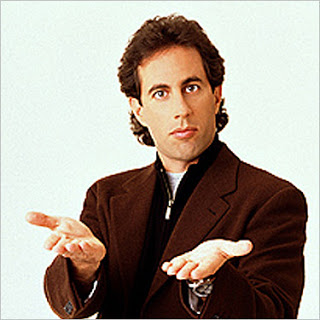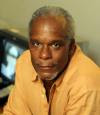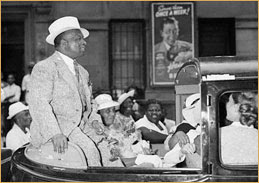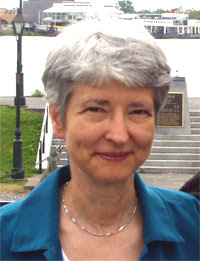VISITS UC-SANTA CRUZ THIS WEEK TO LECTURE STUDENTS ON "HOW TO WRITE HISTORY" IN DOCUMENTARIES....
There he was, smirking and bantering about the usual edifying subjects, such as tossing trash in movie theatres. It was more than a mild shock to see my favorite comedian, the sometimes "master of his domain" walk out on that stage at the Kodak Theatre to take charge of a very special nomination list on Hollywood's holy night.

That list Jerry Seinfeld read at the Academy Awards on February 25 named the five nominated best documentaries of 2006, out of which, of course, "An Inconvenient Truth" got the Oscar. The ultimate winner was the Academy itself, and all of us.
Unlike the Grand Army of the Obtuse that makes up nearly all of our film critics, Academy voters had the wisdom to give thumbs down to a piece of cult apologist cinema that's brought new meaning to the reckless disregard for another "inconvenient truth."
In reality, a multitude of inconvenient truths are suppressed ruthlessly and repeatedly--in "Jonestown: The Life and Death of People's Temple"
 Director Stanley Nelson's editing tricks in his "Jonestown: The Life and Death of People's Temple" easily sent nearly every movie critic swooning, yet another reminder about film's power over those ignorant of history.
Director Stanley Nelson's editing tricks in his "Jonestown: The Life and Death of People's Temple" easily sent nearly every movie critic swooning, yet another reminder about film's power over those ignorant of history.Nelson's film is a potent propaganda showcase, largely owing to its subject matter, of course. No questioning his craft, folks. This is one gunslinger that doesn't miss his mark: He fuses together enough of the "correct" film clips of the cult; enough of the "correct" heart-wrenching, toe-tapping music; and enough of the "correct" interviews rigged to paint a portrait of a cult that was, as one interviewee claims, "vibrant" right up to the day before mass-murder in Jonestown.
"Vibrant?" So the forced labor, malnutrition, and torture (which started in California, protected by the media), was secondary. "Vibrant" isn't the only superlative our "documentarian" has cherry picked from carefully screened interviewees in redecorating what social psychologists have concluded as one of history's most destructive cults.
In Nelson's 90-minute window dressing, this group of brainwashed people that burned little children with cattle prods -- for years, in California, while the "crusading media" did nothing-- has a whole lot more than "vibrant" attached to it.
Here are some of Nelson's sweetened-up interview samplings: „"..People's Temple truly had the potential to be something big - something powerful" "As soon as I walked in (the Temple), I was home""...Every single person felt like they had a role there." Everyone felt like they were exceptionally special..." "There were many reasons to love, admire, overlook, and excuse the things Jim did."
Yes. Of course. While a gang of your frenzied fellow cultists are electro-shocking your five year-old for being "naughty, you just keep countin' ALL the heart-wrenching reasons to admire the great social activist, "Father" Jones. Not a big problem, though, since this perverted version of a rainbow coalition mutated out of the deadly efficient mind control and terror tactics employed by Jones', with an always helpful little nudge from those Temple "Angels of Death" (his gun-toting enforcers).
Nelson, however, doesn't see the need to go through the motions of excusing such inconvenient truths. For instance, his documentary remarkably covers up ANY MENTION WHATSOEVER of the horrendous children's torture feature, "Blue Eyed Monster," practiced by the People's Temple, in the California years, which he instead has papered over in some of the most disgraceful, dishonest film making on record.
Card stacking
Insidious, but a tried & true method in many scenarios. Nelson used one of the oldest tactics in a playbook traditionally employed by conmen strictly out to make a buck - "card stacking," - defined as follows:
Card stacking refers to the method of intentionally deceiving people so that they will support a cause or ideal in which the propagandist strongly believes or from which he or she will realize financial gain. The term originated from the magician's gimmick of "Stacking the deck," which involves presenting a deck of cards that appears to have been randomly-shuffled but which is, in fact, in a pre-conceived and logical order. The magician knows the order and is able to predict or control the outcome of the trick; the audience is unaware of the gimmick. In poker a deck can be 'stacked' so certain hands are dealt to certain players.
Card stacking is full of half-truths, outright lies, omissions, and distortions.
Of course, Stan's in this mainly to score points as the genius film maker he is, on behalf of what he's digested from his meals at Becky Moore and Mac McGehee Jonestown Institute Inn. They happily held his hand and guided him in finding the "right" info and interviewees, and, yes, would include token citations of those unsavory sides of the cult, but in "just the right measure."
Take the interview of the married male cult member who related the time a young male made an announcement regarding "Father" Jones' sexual predations on the other men. Nelson finishes the scene with the interviewee laughing and making light of it.
Stack a card, Stan.
Another interview, a cult member recounts one of the cult's physical tortures carried out, "the boxing punishment." He told about throwing water on someone he had beaten unconscious, and then being forced to beat him further. He then related how "tiring" it was having to fight five people in one night.
Once again, like the sexual predation scene, Nelson films the cult member laughing over this horrifying ordeal. Once again; is this something a responsible director edits into making light of? Minimize--the facts (and these are just a bare few of the unsavory that are disclosed) of a boxing torture and Jones sexually preying on males?
Stack another one, Stan.
On the other hand, the "positives" are hand-dipped in super-sweet seductive coating. You only have to see the film's trailer on Nelson's website, showing that staged clip of smiling, hugging, laughing, happy Temple folks to realize something is amiss. That is, unless you have some notion that destructive cults deserve a second look. It is safe to say that you (a) were too young too recall the People's Temple, (b) are a fanatic in the "New Religious Movements," or (c) should do some homework.
While Stan boasted openly about making "somewhat objective" documentaries this year to the New York Times, he and wife/writer Marcia Smith's credibility was called into question three years ago for another of their films, "Beyond Brown: Pursuing the Promise," in a May, 2004 Washington Post Live Online program.
A caller from Austin, Texas had caught them ˜playing fast and loose with history..." "I honor and understand the meaning of Brown vs. Topeka board of Education," said the unnamed caller, "However, I do not understand the glossing over of facts to sell the story."
In a November, 2006 KQED (San Francisco) Radio interview, Nelson trumpeted for the umpteenth time the Big Lie that he has so cleverly mesmerized much of the public with in his film. People's Temple, you ask?
"They delivered on their promise," said Stan, of the cult that practiced forced labor, death threats, malnutrition, extortion, child abuse, torture, all occurring in California.
"They shared a lot of love," said Stan.
Media knuckle-heads like Pittsburgh Post-Gazette critic Barry Paris are enchanted by the Temple "delivery," with enough superlatives to get Jonestown Apologists CEOs Becky Moore and Mac McGhee worked up into a fever-pitch Irish jig just in time for upcoming St. Patty's Day.
"Jones, after all, was a bona-fide civil rights pioneer..." gushed Paris, "...He built a congregation that promised food, clothing, shelter and retirement homes to its people and delivered. Sure, folks had to give a 20-percent tithe (which evolved into giving all their money and possessions) to the church, but that wasn't so unusual and they did it voluntarily. In the utopian-community, a deal's a deal."
"A deal's a deal." That's right. And like the rest of our witless media "pundits," Paris is completely enamored by the Nelson's "revolutionary" film making process, and just can't be bothered with the possibility of any missing pieces. I wonder if Paris, for example, has ever even heard of Father Divine. Or does he even give a damn about it.
Nelson surely has. In fact, his wife Marcia mentioned Divine at the world premiere of their film, way back in January, 2006, in Salt Lake City, Utah, when they gathered with, oh, that's right, Becky Moore of all people! Salt Lake City, of all places, too. Home base of the Mormon Church. Not that this would be construed as some strategy to "snuggle up" our hard-working cult apologists (NRM's) with an established church, oh, Lord no.
 Father Divine was an African-American cult leader in the 1930s, who established a famed interracial "flock," which Jones modeled himself after. Nelson has completely suppressed any mention whatsoever of Divine in his film, another of these dazzling "card-stackings" in his film's fixed deck. Why? Because the ruthless tactics Jones acquired from observing Divine in a 1957 visit to his Philadelphia cult center would simply not fit in with the notion of pre-Guyana "love-love-love" and "delivery of promises." (Jones, moreover, later tried to steal membership from Divine's cult, unsuccessfully---YET ANOTHER FACT SUPPRESSED BY NELSON. Why??)
Father Divine was an African-American cult leader in the 1930s, who established a famed interracial "flock," which Jones modeled himself after. Nelson has completely suppressed any mention whatsoever of Divine in his film, another of these dazzling "card-stackings" in his film's fixed deck. Why? Because the ruthless tactics Jones acquired from observing Divine in a 1957 visit to his Philadelphia cult center would simply not fit in with the notion of pre-Guyana "love-love-love" and "delivery of promises." (Jones, moreover, later tried to steal membership from Divine's cult, unsuccessfully---YET ANOTHER FACT SUPPRESSED BY NELSON. Why??)"A turning point in JJ‚s career was his meeting with Father Divine, the legendary black pastor from Philadelphia," writes Maurice Brinton, author of "Suicide For Socialism." "Jones was vastly impressed both by his spell-binding preaching techniques and by the total control he still exerted on his congregation (which consisted mainly of elderly black women). From Divine, Jones learned all about "organizing congregations‚" about how to use an "Interrogation Committee‚" He saw the Committee as the logical extension of his grip on his flock."
In Indianapolis, Jones started to surround himself with a group of "totally loyal‚" men and women, black and white. They would watch and report to Jones on the other parishioners. This was probably the first instance in history of a totally integrated, "non-racist‚" Secret Police. Thomas Dixon, one of the early members of the Temple, broke with JJ on this issue. "The Committee‚" he said, "was primarily to deal with those who disagreed with Jones. Whoever was summoned by the Committee was grilled for hours on end with questions such as "Why are you against the Reverend?"
Integration, especially pre-Civil Rights era, was a bold, brave act, absolutely. But AT THIS COST? This, in essence, is the utter disgrace of Nelson's film - his deliberate cover up of Father Divine's critical impact on Jones and Jones's totalitarian savagery that began percolating all the way back to the Indianapolis years and grew exponentially as the cult drifted to California, and to its final tragic end in Guyana.
But our stunningly astute in Pennsylvania critic swallowed Stan's Subterfuge like a four-year old would gobble down a bowl of sugar pops.
"Watching footage of Jones‚ congregants building their church and homes and tilling the soil in their communal farm in Guyana," wrote Paris of Pittsburg, "we see that most of them are clearly quite happy. The irony is that, in many ways, Jonestown was succeeding, not failing and Jones had done an impressive job of carving out a self-sufficient collective community there."
Clearly quite happy?? As, say, the Jonestown children being repeatedly dunked at the bottom of community well (Jonestown's "Big Foot" attraction), screaming over and over in the middle of the night for a mommy or daddy to rescue them. But who never arrived, thanks to the "impressive" effects of being drugged, beaten, starved, brainwashed, and forced back by gunmen.
The reality of course was that Mr. Green Jeans Jones' little ol' "communal farm" (thank you, "Jonestown Institute" Bank of Depraved Euphemisms) was nothing more than a gulag. Nice work Stan--Paris is convinced he was looking at scenes from Disney's Frontierland.
 Perhaps Paris Hilton could give a more reliable assessment the next time.
Perhaps Paris Hilton could give a more reliable assessment the next time.ALERT:
Now here's a news flash for all of you in California who'd like to have a genuine crack at this big rotten egg that the Nelsons have laid. Tomorrow and Wednesday, March 6 and 7, none other than Stanley and Mrs. Nelson will be making a personal appearance at the Univ. of Calif-Santa Cruz campus. On Tuesday evening, at 7 p.m., at Classroom Unit 2, there will be another of their free screenings (get yer free cult conditioner narcotics, students!....Time to alert CultsOnCampus.com)
The day after tomorrow, Wednesday, March 7, Stan and Marcia will appear at noon in the Mural Room at Oakes College Campus, to participate in a conference. This will be the real entertainment. If you've seen the film by now, you should have more than enough inquiries to present Mr. and Mrs. Nelson about this putrid blob of revisionism. Don't expect any straight answers, of course, but at least they can face more than the mush the media reviewers have been offering them. And the topic of the conference is a downright scream (Ah, "Hello, is Orwell in the House??!!"):
"How To Write History: Research and Representation in the Historical Documentary." Okay, so we all now know the folks at UC-Santa Cruz have a good sense of humor. Twisted, but rousing.
In another, more serious milieu, a Nelson-attended conference might better be titled "How to Write Sophistry: Faulty Research and Card-stacking Technique in a Historical Documentary." What is vitally important is that students and visitors not give the Nelsons a free ride, like the critics have.
Get out there and grill them with questions, people!
Besides the major role of Father Divine, you could ask Nelson:
Why did he leave out the role of Tim Stoen, Jim Jones's top enforcer? Without Stoen's legal terror tactics, exposes long before 1977 would have been published that would have put the cult out of business. Stoen later lied publicly, long after Jonestown, about having been in Jones's "inner circle," in a self-serving ploy to get his old job back in the Mendocino District Attorney's Office.
 Nelson, predictably, will have some flimsy excuse for censoring Tim Stoen. Last summer when confronted by my father and me at a film screening, he claimed it was "another one of the stories that we wish we had been able to include."
Nelson, predictably, will have some flimsy excuse for censoring Tim Stoen. Last summer when confronted by my father and me at a film screening, he claimed it was "another one of the stories that we wish we had been able to include."This is where Nelson jumps from disingenuous into Stoen's camp outright lying. I doubt there was even the slightest shred of desire to include Stoen. And that is yet another in this parade of countless outrages.
Suppose Nelson had presented us with a film, "Steel Revolutionary: Life and Death of Stalin." And he had, time after time after time, deleted, embellished, minimized, and sugar-coated this monster's rise and fall. (No, of course, Jones didn't kill as many or rule a nation, etc. - but he ruled his little empire like a Stalinist.)

Millions deliberately starved to death in the Ukrainian forced famine. But what if Nelson shows footage of families happily working in the fields. Millions are sent to forced labor camps. Nelson's footage shows dancing Russians, and kids getting free schools and medical care.
Such lethal omissions about history can have devastating consequences on the future. You know what the saying is about not learning the lessons of history and its consequences--made famous on that forboding sign in that horrifying pavilion.
Here's another hypothetical in a Nelson film on Stalin: Our "revolutionary" director decides to leave the audience almost completely in the dark about Leon Trotsky. Trotsky, who was Stalin's rival, later assassinated, might have succeeded in stopping the monster in his assent to power, had he been more astute politically and made certain Lenin's Testament had been read publicly.
But Trotsky never did. The Testament was censored in the USSR. And he, and millions of people, paid dearly for it. Still, Nelson decides, "Well, I just don't have room for Trotsky in this story, sorry about that....!" Responsible, accurate way to "write history"??
Some directors, it seems, are more than willing to leave out key facts as such, if it suits their "ideology agenda." You can love Michael Moore or hate 'em; his film "Fahrenheit 911" had a couple of scenes that stick out as some of the most appalling instances of this syndrome. The first scene has an American soldier in Iraq singing to a heavy metal song, "...let the motherf----- burn, burn motherf-----, burn..." The other shows, just prior to the U.S. invasion, Moore's POV (point of view - film jargon, that is) of Saddam's brutal regime: Kids are playing, a wedding, and people are laughing. No scenes of Saddam's torture chambers in the montage.
This--a "documentary?" Oh, almost forgot. Nelson worked for Moore one time.
But then, it would be unfair to pick on just poor ol' Stan. No, indeed. As said at the start, this People's Temple Rogue's Gallery is enormous. There are so, so many more to discuss and confront. So many that helped that Beast Jones, who they DEFENDED and PROMOTED SHAMELESSLY ...reporters, columnists, editors, talk show hosts, clergy, lawyers, state assemblymen..it is mind-boggling. Many of them have turned revisionists, like Nelson, and lie compulsively, like Nelson, in order to maintain their place in the limelight.
Truly sickening. It's time to set the record straight.
The next Jonestown Apologists Alert will premiere a special series of stories, exposes that you, the public, should and must read. The San Francisco Examiner, when it was still a "functioning" newspaper, published a three-part series back in November, 1998, on the 20th Anniversary of Jonestown.
It was called "Days of Darkness." Then-Executive Editor Phil Bronstein made the following breath-taking promise:
"The Examiner owes it to its readers ...to publish a series that goes far beyond a recollection of what happened. What we hope to do in these stories is raise and answer key questions that still haunt us all about Rev. Jim Jones and the tragedy that befell his followers˜and all San Franciscans˜two decades ago."
But of course predictably what Bronstein, now at the S.F. Chronicle, then offered up was the same, tired old fabricated garbage the California media has continued spewing out non-stop for what is now close to 30 years. This heap of self-congratulatory drivel is designed to cover up their weakness, stupidity, and cowardice in not shutting down Jones and his Temple Mafia when they easily had the chance. Bronstein, you--and the rest--STILL OWE.
 When there was still time to do it. A time such as September, 1972, when my father, Les Kinsolving, was honing in on them like a Hellcat fighter in the Pacific.
When there was still time to do it. A time such as September, 1972, when my father, Les Kinsolving, was honing in on them like a Hellcat fighter in the Pacific.He had eight exposes set to run in the Examiner of the fraudulent, menacing cult. Four, however, never saw the light of day, thanks to Jones enforcer Tim Stoen (who later apologized for his actions, whose motives are still unclear).
The first expose, "The Prophet Who Raises The Dead," ran on the front page of The Examiner, Sunday, Sept. 17, 1972. Those that have wanted it, or the other three, never published again, for their own self-serving, immoral reasons, will now no longer have their way. These, and the other four exposes that were originally censored under the threat of Jones and Stoen's law suits, will be published in their chilling entirety right here.
Then you'll understand that one of the greatest crimes was simply that the Jonestown Massacre never needed to happen, only for the fact that the Examiner, and the rest of the California media lost their backbone in 1972--but will still not own up to it. And it's clear that our Cult Appologist film maker has thrown that one, as well, into his cinematic chamber of secrets. He's consistent, people.
Stanley Nelson, in his KQED program, proclaimed that [not until 1977] "Marshall Kilduff rang the first alarm about People's Temple!"
Tomorrow and Wednesday, when Nelson appears at UC Santa Cruz, and gives instructions on "How To Write History: Research and Representation in the Historical Documentary, " will he continue displaying the same level of candor?





